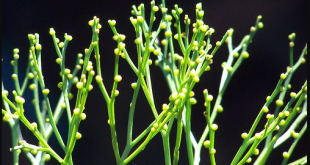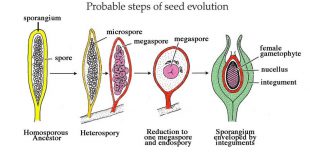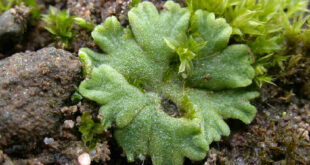Telome theory was proposed by Walter Zimmerman (1952, 1965). This theory is based on fossil records and explains the major steps in the evolution of vascular plants. According to this theory, all vascular plants have evolved from simple, leaf-less, root-less and dichotomously branched sterile and fertile axes called telomes which originated from an algal ancestor. The telome may be fertile having a single terminal sporangium or sterile without sporangia. But what is telome?

A telome is a “branch having no leaves but dichotomous branching at either apex or at the base or both” i.e., it is the point of the most distal dichotomy to the tip of a branch. The connecting axes between the dichotomies are mesomes.
Functionally, telomes are of two types viz., fertile telome and sterile telome.
Fertile telome: Telome that contains sporangia.
Sterile telome: Those terminal branches without sporangia are called sterile (vegetative) telomes.
Telome truss: Several telomes, either fertile or sterile, becomes grouped together by connecting mesomes to form a more complex structure, called syntelome or telome truss.
Telome theory helps us to understand that
- All vascular plants evolved —either directly or indirectly — from a simple leafless Rhynia-type ancestral form made up of sterile and fertile axes (the telomes).
Processes of Telome Theory
According to Zimmermann, these telomes or telome trusses of primitive Rhynia type of vascular plants have been subjected to certain evolutionary processes in varying degrees among the various taxonomic groups.
These evolutionary processes are:
(i) Overtopping
(ii) Reduction
(iii) Plantation
(iv) Syngenesis or webbing
(v) Curvation.
(a) Overtopping
In this process, one of the two dichotomizing branches become larger, and stronger, and grew vertically upward as the main axis. The shorter dichotomy was displaced and thus in this process the weaker branch was overtopped by the stronger branch. It resulted in the development of monopodial branches from equal dichoitomies. Evolutionary studies have also shown that dichotomous branching is frequent in primitive pteridophytes and monopodial in advanced forms.

(b) Reduction:
In this process, the activity of the terminal meristem of each telome of the truss becomes suppressed resulting in much shorter branches by decreasing the length of telomes and mesomes. This process is responsible for the formation of microphyllous leaves of the Lycopsida and Sphenopsida as well as the needle-like leaves of conifers.
(c) Planation
The process of planation caused the telomes and mesomes of the truss to shift from a three-dimensional pattern (cruciate dichotomy) to a single plane (fan-shaped dichotomy). The process ‘webbing’, infilling with photosynthetic and other tissues between the planated branches, has led to the evolution of a flattened leaf-like structure with a dichotomously veined lamina.
(d) Syngenesis
This is an evolutionary process where the tangential fusion of mesomes and telomes takes place. The lateral fusion of sterile vegetative telomes and mesomes resulted in complex anastomosing vascular systems in the stem (e.g., polystelic condition in Selaginella). The fusion of fertile trusses with their terminal sporangia resulted in the formation of synangia of Psilotum. The closed or reticulate venation pattern of some ferns, gymnosperm and many flowering plants is the result of syngenesis of the dichotomizing veins of the primitive leaf.
(e) Curvation
This evolutionary process causes due to the unequal growth of the tissues on two opposite flanks of the telome. It has two sub-processes:
(i) Recurvation
In this sub-process, the telome bends inward toward an axis. The inward-projecting sporangia on a sporangiophore of Equisetum (Sphenopsida) are the result of this sub-process.
(ii) Incurvation
In this sub-process, the fertile telome bends downward resulting in the downward shifting of the sporangia from the terminal to the ventral surface of the leaf. This sub-process is responsible for the formation of the ventral position of the sporangia in the fern (Pteropsida) leaf.
According to Zimmerman microphyllous leaves develop through the reduction process. e.g, Lycopodium, Selaginella.

On the other hand, megaphyllous leaves develop through overtopping, planation, and syngenesis processes. e.g. Pteris, Dryopteris.
Merits of Telome Theory
- Telome theory provides an excellent interpretation of the origin and evolution of sporophytes of land plants.
- It describes the structure of land plants.
- This theory explains the connection between fossil plants and living plants.
Demerits of Telome Theory
- Does not explain how a telome-like characteristic body has been developed.
- No idea was found for the arrangement of sporangia.
- Does not provide an acceptable origin for all leafy structures.
Revised by
- Tarannum Ahsan on 29th Jan 2023.
 Plantlet The Blogging Platform of Department of Botany, University of Dhaka
Plantlet The Blogging Platform of Department of Botany, University of Dhaka






Thank you for your sharing. I am worried that I lack creative ideas. It is your article that makes me full of hope. Thank you. But, I have a question, can you help me?